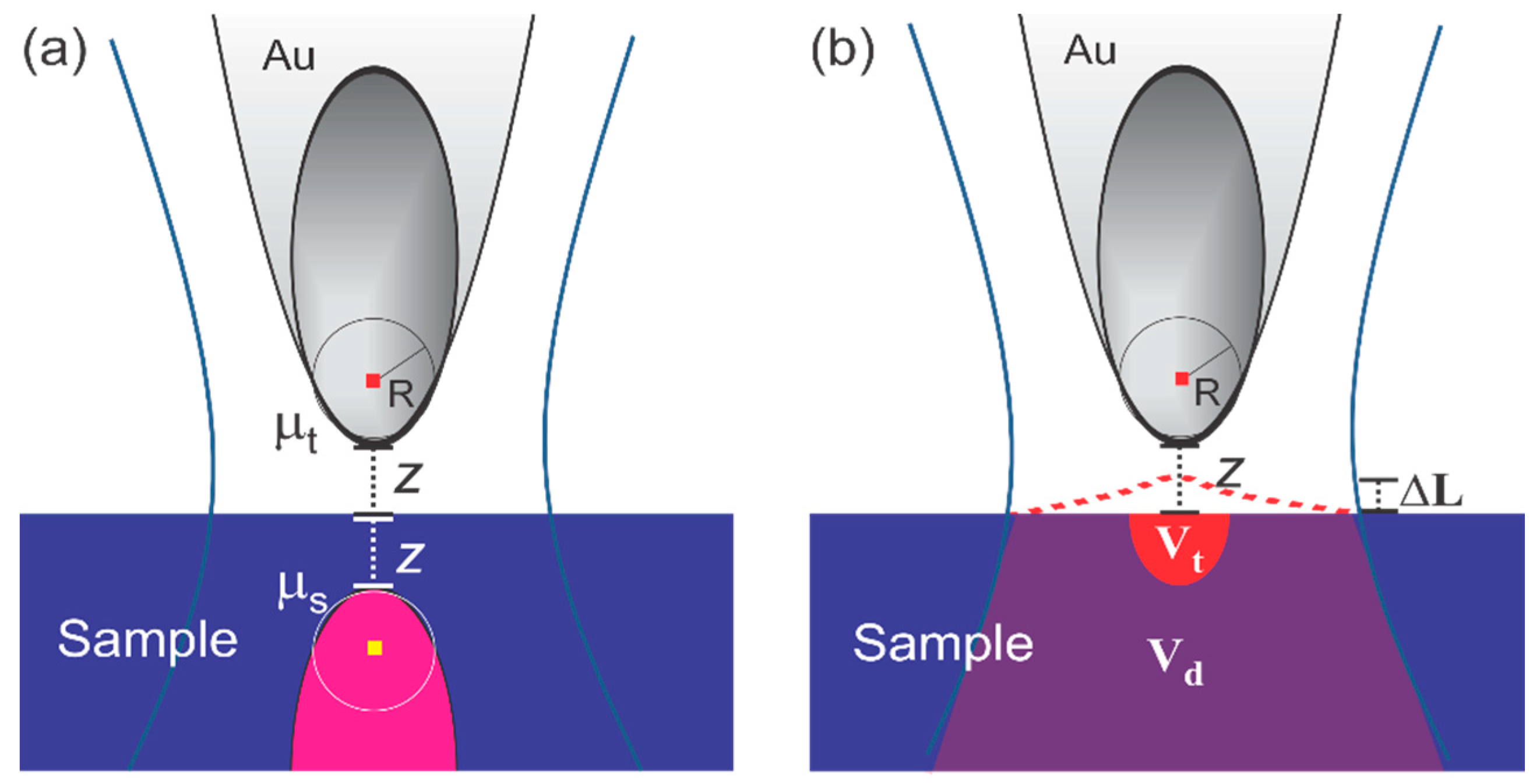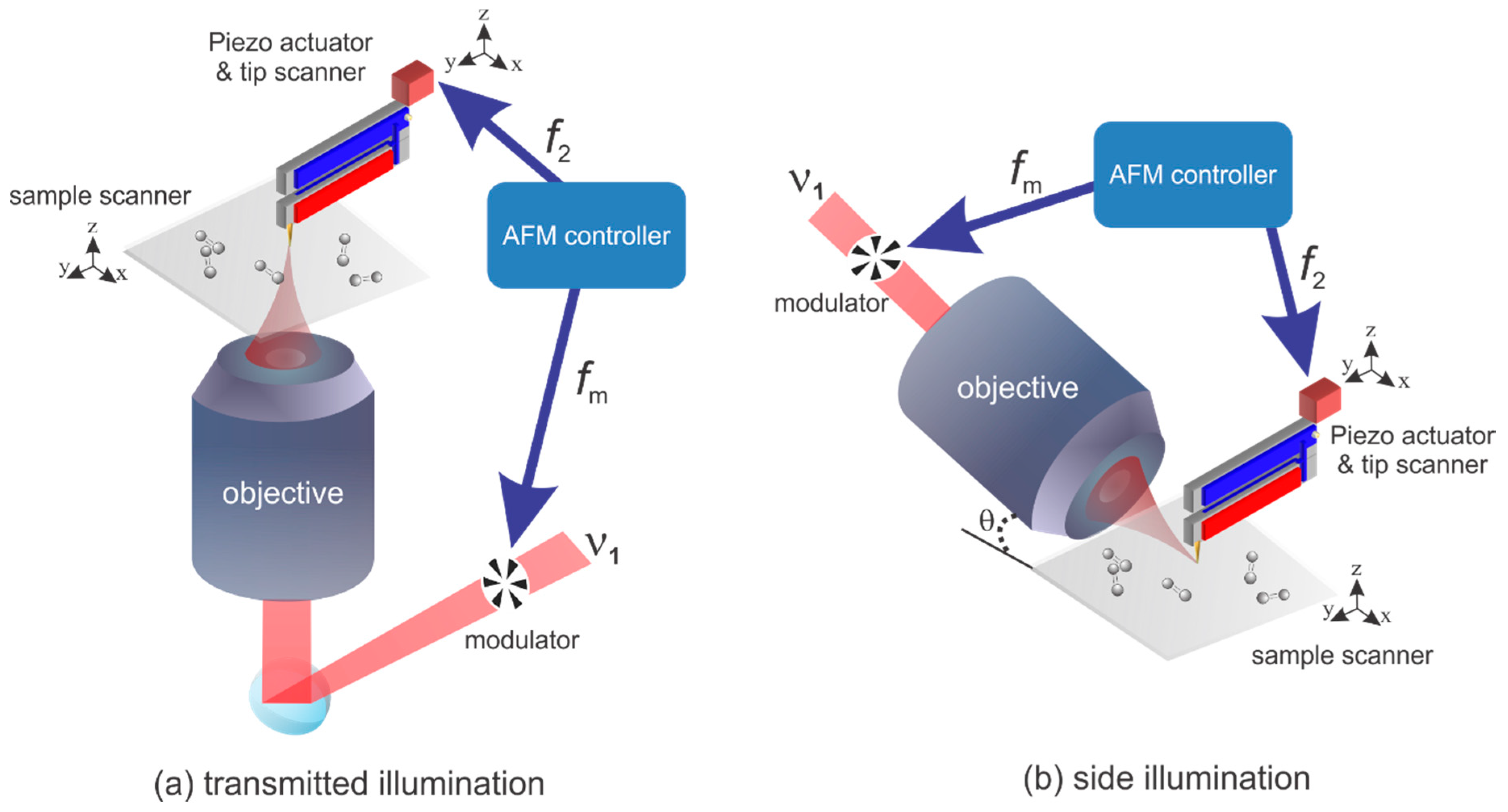Photo-Induced Force Microscopy by Using Quartz Tuning-Fork Sensor
Abstract
:1. Introduction
2. Materials and Methods
2.1. Photo-Induced Forces
2.1.1. Optical Field Gradient and Scattering Force
2.1.2. Thermal Expansion Force Mediated by Intermolecular Interaction between Tip and Sample
2.1.3. PiFM Sideband Coupling Dynamics
2.2. PiFM Measurements
2.2.1. Instruments
2.2.2. Sensitivity of a Probe in PiFM
2.3. Sample Preparation
3. Results
4. Discussion
5. Conclusions
Author Contributions
Funding
Conflicts of Interest
References
- Rajapaksa, I.; Uenal, K.; Wickramasinghe, H.K. Image force microscopy of molecular resonance: A microscope principle. Appl. Phys. Lett. 2010, 97, 073121. [Google Scholar] [CrossRef] [Green Version]
- Jahng, J.; Brocious, J.; Fishman, D.A.; Huang, F.; Li, X.; Tamma, V.A.; Wickramasinghe, H.K.; Potma, E.O. Gradient and scattering forces in photoinduced force microscopy. Phys. Rev. B 2014, 90, 55417. [Google Scholar] [CrossRef]
- Jahng, J.; Ladani, F.T.; Khan, R.M.; Li, X.; Lee, E.S.; Potma, E.O. Visualizing surface plasmon polaritons by their gradient force. Opt. Lett. 2015, 40, 5058–5061. [Google Scholar] [CrossRef] [PubMed]
- Huang, F.; Tamma, V.A.; Mardy, Z.; Burdett, J.; Wickramasinghe, H.K. Imaging nanoscale electromagnetic near-field distributions using optical forces. Sci. Rep. 2015, 5, 10610. [Google Scholar] [CrossRef]
- Tumkur, T.U.; Yang, X.; Cerjan, B.; Halas, N.J.; Nordlander, P.; Thomann, I. Photoinduced force mapping of plasmonic nanostructures. Nano Lett. 2016, 16, 7942–7949. [Google Scholar] [CrossRef]
- Jahng, J.; Brocious, J.; Fishman, D.A.; Yampolsky, S.; Nowak, D.; Huang, F.; Apkarian, V.A.; Wickramasinghe, H.K.; Potma, E.O. Ultrafast pump-probe force microscopy with nanoscale resolution. Appl. Phys. Lett. 2015, 106, 083113. [Google Scholar] [CrossRef] [Green Version]
- Jahng, J.; Potma, E.O.; Lee, E.S. Tip-Enhanced Thermal Expansion Force for Nanoscale Chemical Imaging and Spectroscopy in Photoinduced Force Microscopy. Anal. Chem. 2018, 90, 11054–11061. [Google Scholar] [CrossRef] [PubMed]
- Rajapaksa, I.; Wickramasinghe, H.K. Raman spectroscopy and microscopy based on mechanical force detection. Appl. Phys. Lett. 2011, 99, 161103. [Google Scholar] [CrossRef] [PubMed]
- Jahng, J.; Fishman, D.A.; Park, S.; Nowak, D.B.; Morrison, W.A.; Wickramasinghe, H.K.; Potma, E.O. Linear and nonlinear optical spectroscopy at the nanoscale with photoinduced force microscopy. Acc. Chem. Res. 2015, 48, 2671–2679. [Google Scholar] [CrossRef] [PubMed]
- Nowak, D.; Morrison, W.; Wickramasinghe, H.K.; Jahng, J.; Potma, E.; Wan, L.; Ruiz, R.; Albrecht, T.R.; Schmidt, K.; Frommer, J.; et al. Nanoscale chemical imaging by photoinduced force microscopy. Sci. Adv. 2016, 2, e1501571. [Google Scholar] [CrossRef] [Green Version]
- Murdick, R.A.; Morrison, W.; Nowak, D.; Albrecht, T.R.; Jahng, J.; Park, S. Photoinduced force microscopy: A technique for hyperspectral nanochemical mapping. Jpn. J. Appl. Phys. 2017, 56, 08LA04. [Google Scholar] [CrossRef] [Green Version]
- Jahng, J.; Lee, M.; Stambaugh, C.; Bak, W.; Jhe, W. Active feedback cooling of massive electromechanical quartz resonators. Phys. Rev. A 2011, 84, 022318. [Google Scholar] [CrossRef]
- Jahng, J.; Ladani, F.T.; Khan, R.M.; Potma, E.O. Photo-induced force for spectroscopic imaging at the nanoscale, Complex Light and Optical Forces X. Int. Soc. Opt. Photonics 2016, 9764, 97641J. [Google Scholar]
- Huang, Y.; Legrand, D.; Vincent, R.; Dogbe Foli, E.A.; Nowak, D.; Lerondel, G.; Bachelot, R.; Taliercio, T.; Barho, F.; Cerutti, L. Spectroscopic Nanoimaging of All-Semiconductor Plasmonic Gratings Using Photoinduced Force and Scattering Type Nanoscopy. ACS Photonics 2018, 5, 4352–4359. [Google Scholar] [CrossRef]
- Almajhadi, M.; Wickramasinghe, H.K. Contrast and imaging performance in photo induced force microscopy. Opt. Express 2017, 25, 26923–26938. [Google Scholar] [CrossRef]
- Ladani, F.T.; Potma, E.O. Dyadic Green’s function formalism for photoinduced forces in tip-sample nanojunctions. Phys. Rev. B 2017, 95, 205440. [Google Scholar] [CrossRef]
- Yang, H.U.; Raschke, M.B. Resonant optical gradient force interaction for nano-imaging and-spectroscopy. N. J. Phys. 2016, 18, 053042. [Google Scholar] [CrossRef]
- Wang, L.; Wang, H.; Vezenov, D.; Xu, X.G. Direct Measurement of Photoinduced Force for Nanoscale Infrared Spectroscopy and Chemical-Sensitive Imaging. J. Phys. Chem. C 2018, 122, 23808–23813. [Google Scholar] [CrossRef]
- Jahng, J.; Kim, B.; Lee, E.S.; Potma, E.O. Quantitative analysis of sideband coupling in photoinduced force microscopy. Phys. Rev.B 2016, 94, 195407. [Google Scholar] [CrossRef]
- Kim, B.; Jahng, J.; Khan, R.M.; Park, S.; Potma, E.O. Eigenmodes of a quartz tuning fork and their application to photoinduced force microscopy. Phys. Rev. B 2017, 95, 075440. [Google Scholar] [CrossRef] [Green Version]
- Gallagher, P.; Li, Y.; Watanabe, K.; Taniguchi, T.; Heinz, T.F.; Goldhaber-Gordon, D. Optical imaging and spectroscopic characterization of self-assembled environmental adsorbates on graphene. Nano Lett. 2018, 18, 2603–2608. [Google Scholar] [CrossRef] [PubMed]
- Jahng, J.; Yang, H.; Lee, E.S. Substructure imaging of heterogeneous nanomaterials with enhanced refractive index contrast by using a functionalized tip in photoinduced force microscopy. Light Sci. Appl. 2018, 7, 73. [Google Scholar] [CrossRef] [PubMed]





© 2019 by the authors. Licensee MDPI, Basel, Switzerland. This article is an open access article distributed under the terms and conditions of the Creative Commons Attribution (CC BY) license (http://creativecommons.org/licenses/by/4.0/).
Share and Cite
Jahng, J.; Kwon, H.; Lee, E.S. Photo-Induced Force Microscopy by Using Quartz Tuning-Fork Sensor. Sensors 2019, 19, 1530. https://doi.org/10.3390/s19071530
Jahng J, Kwon H, Lee ES. Photo-Induced Force Microscopy by Using Quartz Tuning-Fork Sensor. Sensors. 2019; 19(7):1530. https://doi.org/10.3390/s19071530
Chicago/Turabian StyleJahng, Junghoon, Hyuksang Kwon, and Eun Seong Lee. 2019. "Photo-Induced Force Microscopy by Using Quartz Tuning-Fork Sensor" Sensors 19, no. 7: 1530. https://doi.org/10.3390/s19071530




